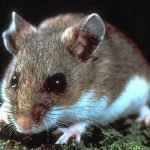The recent news of hantavirus at Yosemite National Park being spread through deer mice droppings took me back to 1993 when I was living on the Navajo Reservation in Window Rock. That spring and summer the reservation was the hit with a high number of victims, ranging in age from 13 to 85, with 60% dying from the disease. I recall my dismay as I learned of the link between mice and the mysterious virus. I had just moved into a rental home that was being overrun with mice.
I ended up getting rid of the mice in my home and never had any symptoms. Shortly before the outbreak, however, a fellow worker had spent the weekend cleaning out her shed, and had gotten extremely ill, something she later surmised was hantavirus, but survived.
I worked as a health professional but was also doing some freelance writing, and wrote about hantavirus for The Navajo Times. I recently came across one of my articles. It discussed a hantavirus conference in Albuquerque in November 1993, where epidemiologist Ben Muneta of the Indian Health Service shared his interviews with traditional elders and medicinemen. I found it fascinating then and thought readers might find it interesting today.
Muneta said Navajo oral tradition spoke of past times when Navajos died of sudden powerful diseases. The most recent occurred in 1918 and 1933, when food sources and rodent populations were high. As in the 1993 outbreak, few people survived.
Traditional Navajo belief says humans and mice should exist in two systems, which are to be totally apart – the outdoor/night world and the indoor world. However, the mouse is not considered evil. In fact, Muneta shared the elders’ and medicinemen’s belief that mice play an important role in the traditional belief of creation. Their spreading of seeds established the present day ecosystem, and mice are considered ‘landlords’ of this world.

“Navajo traditions believe mice to be bearers of illnesses from ancient times if the two worlds mingle,” Muneta had said. Mice are to be excluded from homes because illnesses from them can be transmitted through the air or upon contact. The old Navajo tradition of burning clothes if mice have touched them was a result of this belief. “The elders said this was because of saliva or droppings that may have gotten on the clothes,” Munesa said. But after being ridiculed by western medicine for this belief, it was told less often.
Research has shown that deer mice (Peromyscus maniculatus) were the primary host to the hantavirus that hit the Four Corners of the nation in 1993. Along with being an important food source for various predators, deer mice are important for spreading seeds of many types of plants and the spores of fungi.
Reading my article was a reminder of how history and oral tradition can provide important lessons about illnesses — and relations with our wildlife.
Leave a Reply